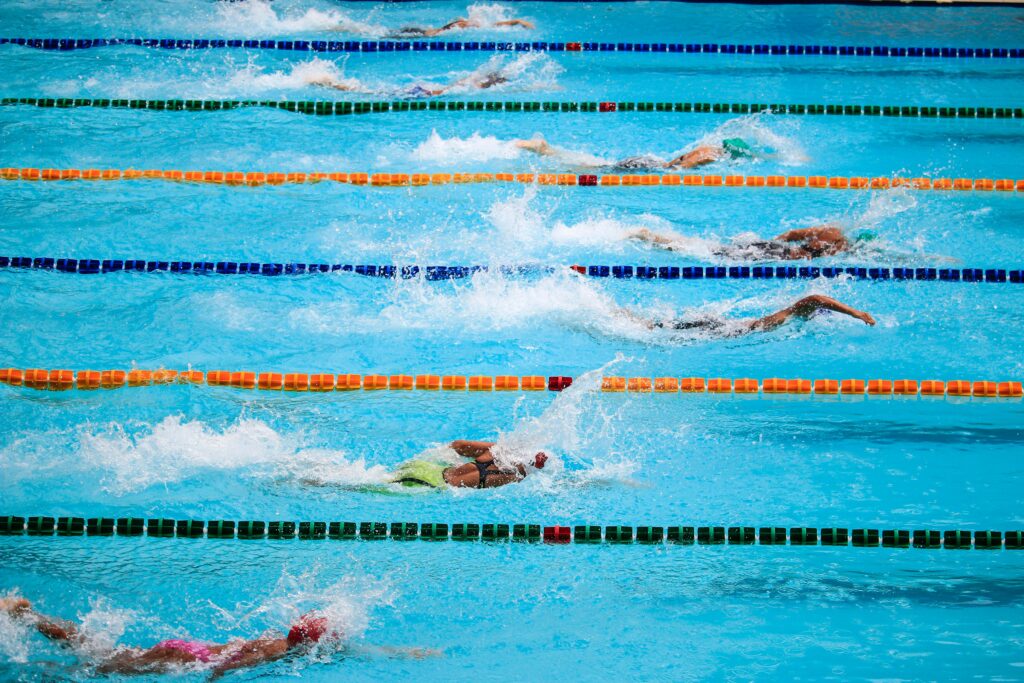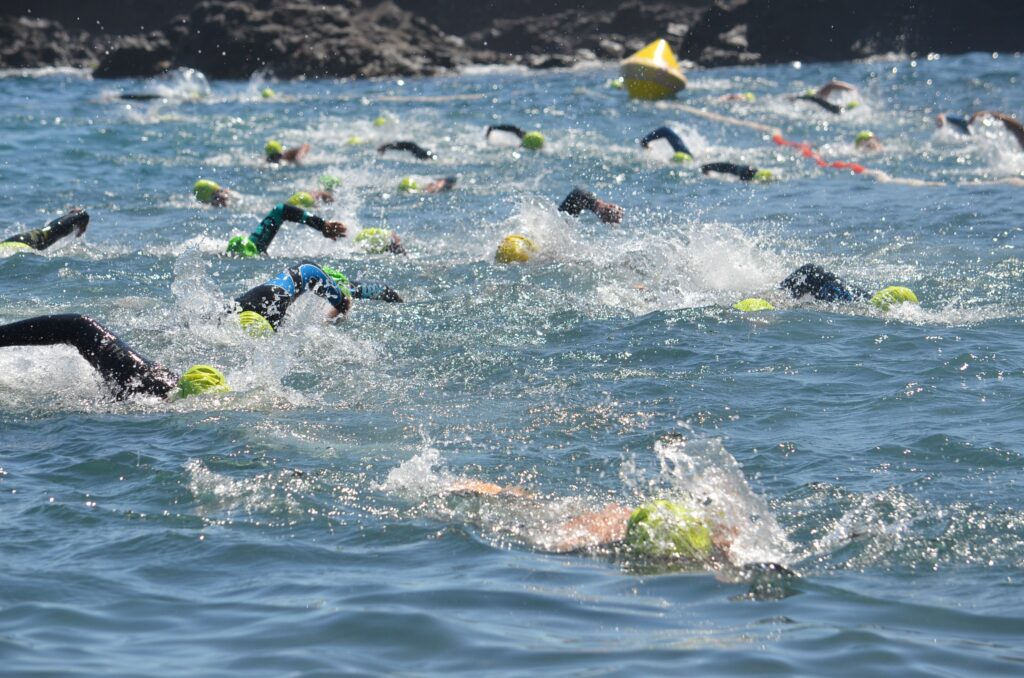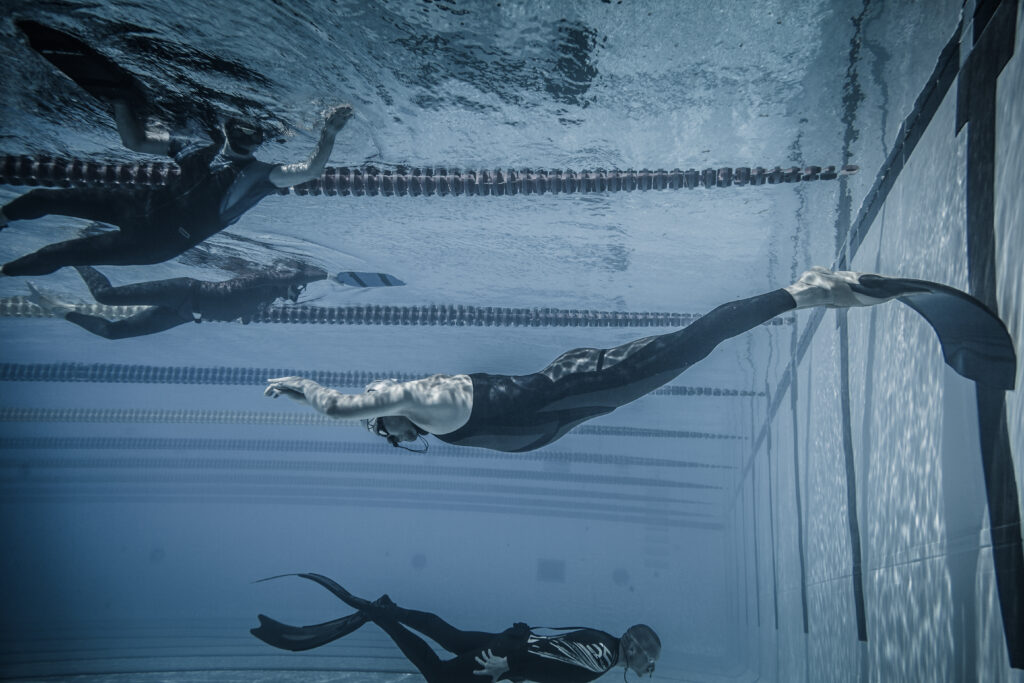A great dive start can make or break a swimming race. It’s the first chance to gain an edge over competitors and set the tone for the entire event. Perfecting your swimming start involves proper positioning on the block, a powerful takeoff, and a clean entry into the water.
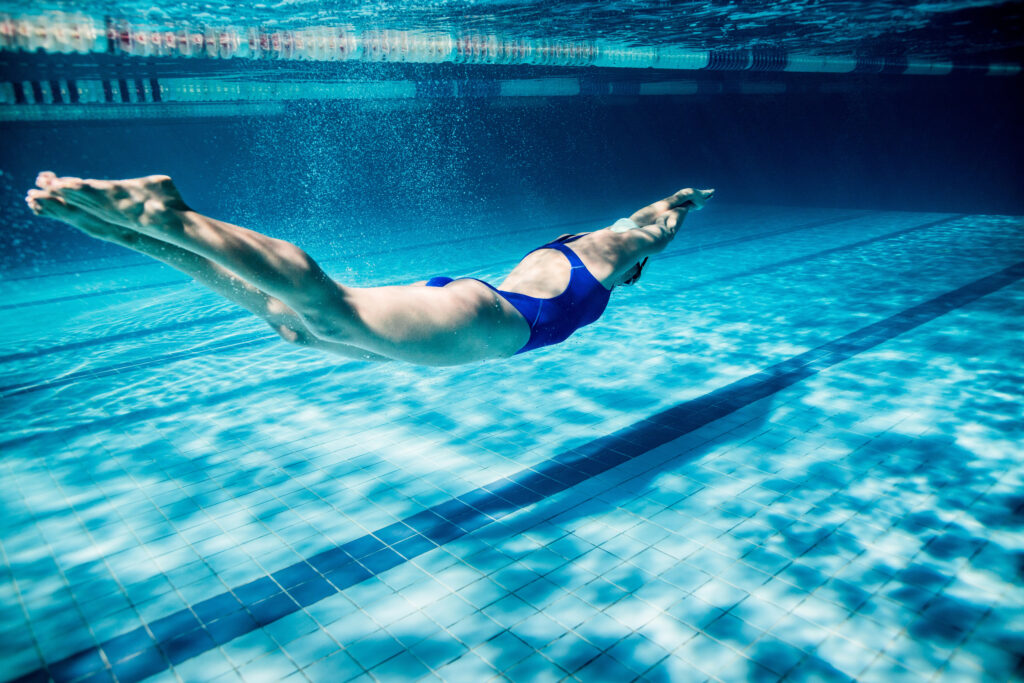
The underwater phase is equally crucial. Swimmers who excel in this area can maintain their momentum and emerge ahead of the pack. A strong underwater dolphin kick and a smooth transition to the surface can give you a significant advantage.
To improve your dive start and underwater section, focus on technique and practice. Drills like the hula hoop exercise can help refine your entry, while working on your core strength will boost your underwater performance. With dedication and the right training, you can shave valuable seconds off your race times.
Key Takeaways
- Proper positioning and technique on the starting block are essential for a powerful dive
- A streamlined entry and strong underwater phase can give swimmers a competitive edge
- Regular practice and targeted drills are key to improving dive starts and underwater performance
Understanding the Basics of Dive Starts
A strong dive start can make or break a swimming race. It’s the first chance to gain an edge over competitors and set the tone for the entire event.
Importance of Reaction Time
Reaction time is crucial in dive starts. Swimmers who react quickly to the starting signal gain a significant advantage. To improve reaction time, practise regularly with a variety of auditory cues.
Elite swimmers often have reaction times of 0.6 to 0.8 seconds. Mental preparation and focus can help reduce this time. Visualisation techniques before the race can prime the body for a faster response.
Dryland exercises like quick hand claps or rapid foot taps can enhance overall reaction speed. Remember, even a fraction of a second can make a difference in competitive swimming.
Types of Dive Starts
There are three main types of dive starts in swimming:
- Track start
- Grab start
- Staggered start
The track start involves one foot at the front of the block and the other at the back, similar to a sprinter’s stance. It allows for a powerful push-off.
The grab start has both feet at the front of the block, with hands gripping the edge. This provides stability and suits swimmers who prefer a more controlled start.
The staggered start is a hybrid, with feet positioned between the track and grab start positions. It combines elements of both techniques.
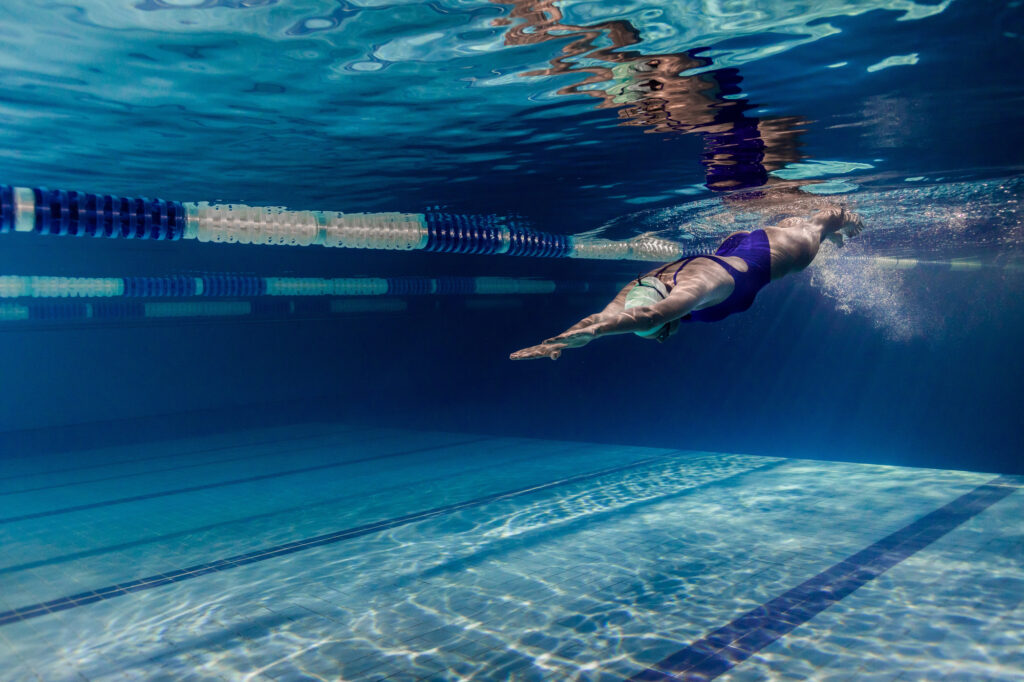
Proper Body Positioning for Dive Starts
Correct body positioning is essential for an effective dive start. The key elements are:
- Head down, eyes focused on the water
- Hips high, creating a downward slope from hips to head
- Arms relaxed, ready to swing forward
- Weight on the balls of the feet
As the starting signal sounds, swimmers should explode forward, using their arms to generate momentum. The body should form a streamlined shape as it enters the water.
Practice different dive styles to find the most comfortable and efficient technique. Remember, a good dive start should feel natural and powerful.
Positioning on the Starting Block
Proper positioning on the starting block is crucial for a fast, powerful dive start. The right stance sets you up for an explosive push-off and streamlined entry into the water.
Front Foot Placement
The front foot plays a key role in generating force for your dive. Place the ball of your front foot at the front edge of the block. Curl your toes over the edge for a secure grip. This position allows you to transfer maximum power through your foot as you push off.
Keep your front foot pointing straight ahead. A crooked foot can lead to a skewed entry. Align your toes with your knee and hip for optimal power transfer.
Experiment with foot placement to find what feels most stable and powerful for you. Some swimmers prefer their stronger leg in front, while others favour their weaker leg to save power for the initial underwater phase.
Back Foot Placement
Your back foot provides stability and contributes to the explosive push-off. Position it towards the rear of the block, with the ball of your foot firmly planted. The heel can be slightly raised for a more dynamic stance.
The distance between your feet should be about hip-width apart. This provides a stable base while allowing for a powerful thrust. Adjust your back foot position to find the sweet spot where you feel balanced and ready to spring forward.
Ensure both feet are pointing straight ahead. This alignment helps direct your momentum forward rather than to the side, leading to a cleaner entry and faster start.
Hand Positioning on the Block
Proper hand placement is essential for balance and initiating the dive. Grasp the front edge of the block with both hands. Your fingers should wrap around the edge, with thumbs on top.
Keep your arms straight but not locked. This position allows you to quickly pull your arms back and forward as you dive, adding momentum to your start.
Your hands should be about shoulder-width apart. This width provides stability and allows for a smooth arm swing during the dive. Some swimmers prefer a slightly wider grip for added stability, while others opt for a narrower grip for a more streamlined entry.
Maintain a relaxed grip to avoid tension in your upper body. This helps you react quickly to the starting signal and execute a fluid dive motion.
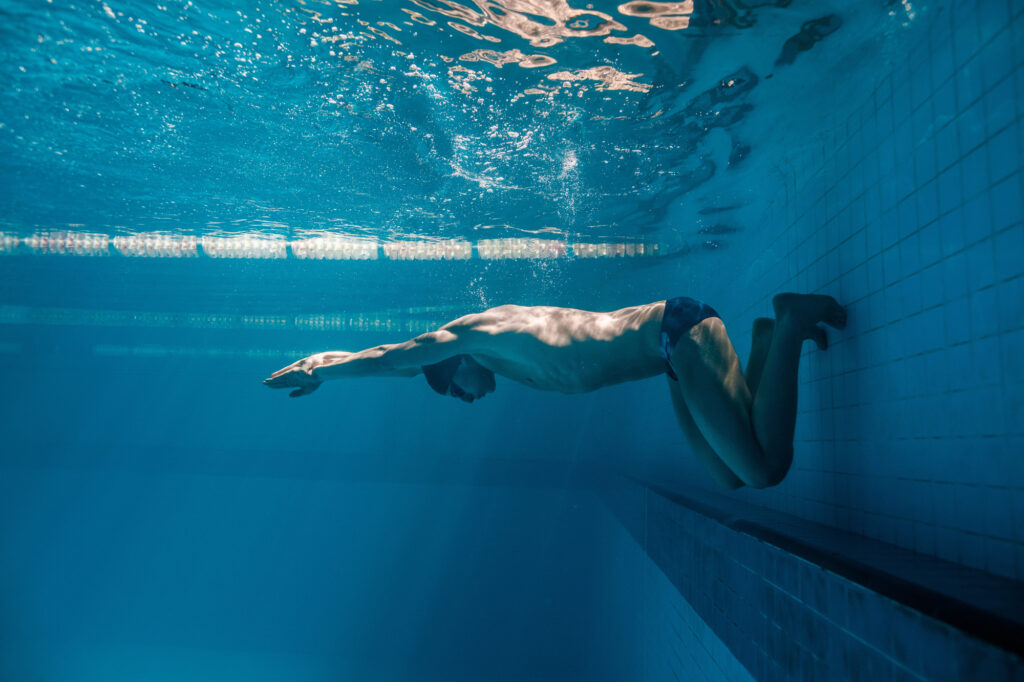
The Take off Phase
The takeoff is crucial for a fast start. It requires power, momentum and proper technique. Mastering this phase can give swimmers a significant advantage.
Building Momentum and Power
To build momentum and power for a strong takeoff, swimmers should focus on their stance and leg drive. Starting blocks are designed to help swimmers generate explosive force.
Place your feet shoulder-width apart on the block. Bend your knees slightly to load your legs with energy. Keep your arms relaxed but ready.
When the starting signal sounds, push off forcefully with both legs. Drive your hips forward and up. This movement creates a powerful thrust.
Use your arms to add extra propulsion. Swing them forward and up as you leave the block. This motion helps lift your body into a streamlined position.
Avoiding Common Mistakes
One frequent error is leaning back before takeoff. This wastes precious time and reduces forward momentum. Instead, keep your weight centred over your feet.
Don’t jump straight up. Aim for a low, flat trajectory to enter the water at the right angle. This helps maintain speed and reduces drag.
Avoid tensing up on the blocks. Stay relaxed but alert. Tension can slow your reaction time and hinder smooth movement.
Don’t rush your arm swing. Time it with your leg drive for maximum effect. A poorly timed arm movement can throw off your balance.
Remember to keep your head in line with your spine. Looking up or down can affect your entry angle and slow you down.
Streamlined Entry into the Water
A streamlined entry is crucial for a fast start in swimming races. It sets the stage for a powerful underwater phase and can give swimmers a competitive edge.
Mastering the Dive Technique
To execute a perfect dive, swimmers should start with their body in a tight, coiled position on the starting block. As they leap forward, they should aim to enter the water with their body fully extended. The hands should pierce the water first, followed by the head and the rest of the body in a smooth, continuous motion.
Swimmers should practise entering the water at a slight angle, aiming for a clean entry that minimises splash. This angle helps maintain forward momentum and reduces drag. A common mistake is diving too deep or too shallow, which can slow the swimmer down.
Achieving a Tight Streamline
Once in the water, maintaining a tight streamline is essential. Swimmers should keep their arms extended above their head, with one hand gripping the other. The biceps should be pressed against the ears, creating a sleek profile.
The legs should be together with pointed toes, forming a straight line from head to toe. This position reduces water resistance and allows swimmers to glide smoothly through the water. Swimmers should hold this streamline position until they begin their underwater dolphin kicks.
Regular practise of streamline drills can help improve body awareness and muscle memory, leading to more efficient entries and faster race starts.
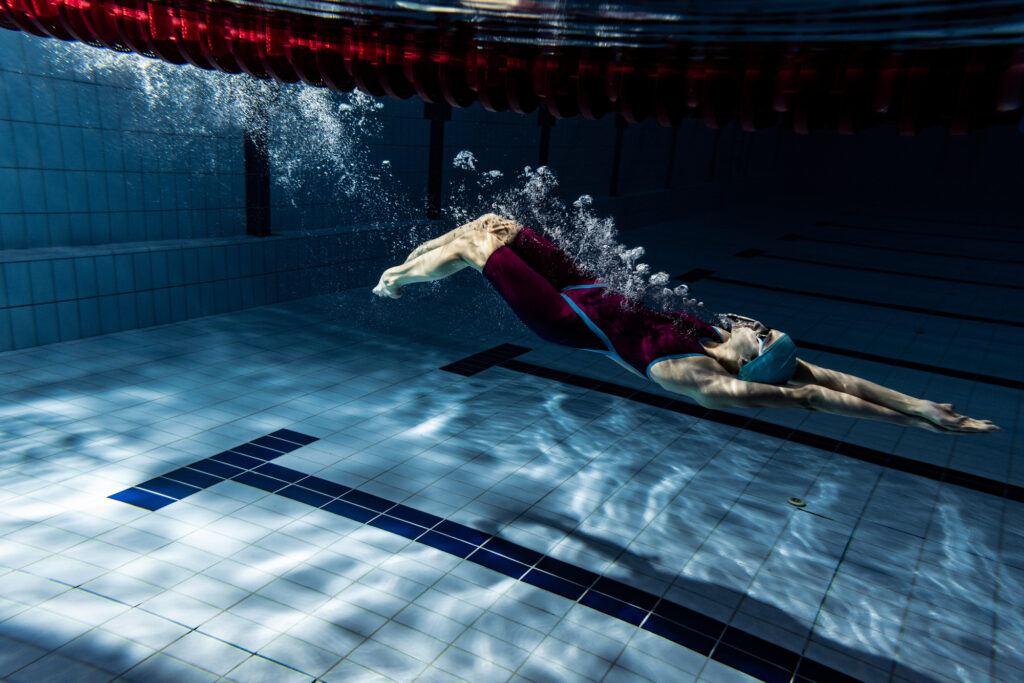
Underwater Phase and Transition to Surface
The underwater phase and transition to surface are crucial elements of a competitive swim start. Mastering these techniques can significantly improve race times and overall performance.
Optimising the Underwater Kick
A powerful underwater kick is essential for maintaining speed after the dive. Swimmers should focus on a strong streamline position to reduce drag. Keep the arms extended overhead with hands clasped, head tucked between the biceps, and core engaged.
Dolphin kicks are the most effective propulsion method underwater. Initiate the movement from the chest, rippling through the hips and legs. Aim for powerful, controlled kicks with minimal knee bend.
Key points for an effective underwater kick: • Maintain a tight, streamlined body position • Use full-body undulation, starting from the chest • Keep kicks narrow and powerful • Practise consistent rhythm and timing
Transition Timing and Technique
The transition from underwater to surface swimming is a critical moment that can make or break a race start. Swimmers must time their breakout to maintain momentum and avoid losing speed.
As they approach the surface, swimmers should gradually decrease the amplitude of their dolphin kicks. The final kick should be the most powerful, propelling them towards the surface.
Optimal breakout technique:
- Begin the first arm pull as the head breaks the surface
- Transition smoothly from dolphin to flutter kicks
- Time the first breath with the second or third arm stroke
Practise these transitions regularly to develop muscle memory and improve consistency in competition settings.
Training and Drills for Enhancing Dive Starts
Dive starts are crucial for swimming success. Proper training and drills can significantly boost start performance, reaction time, and underwater speed.
Specific Drills for Start Improvement
The cactus drill is excellent for enhancing starts. Swimmers begin in a crouched position on the block, then drive their hips back whilst extending their arms into a streamline. This helps improve balance and reinforces a strong streamline position.
Another effective drill is the dive and float. Swimmers practise their dive, then remain in a streamline position without kicking. This drill measures start power and streamline form.
Dry land practice is also valuable. Swimmers can rehearse arm and leg movements on land, focusing on proper technique without water resistance.
Integrating Flexibility and Strength Training
Flexibility plays a key role in start performance. Swimmers should incorporate stretches for their hamstrings, quadriceps, and shoulders into their routine. This increases range of motion and power off the blocks.
Strength training is equally important. Exercises like squats and plyometrics build explosive power in the legs. Core work improves stability and streamline position.
Reaction time drills are crucial. Swimmers can practise quick responses to auditory cues, mimicking the start signal. This helps shave precious milliseconds off their start time.
Regular integration of these drills and exercises into training plans is essential. Consistent practice leads to noticeable improvements in start performance over time.
Mental and Physical Preparation Strategies
Proper preparation is key to a successful dive start and underwater section. Swimmers can boost their performance through targeted mental and physical techniques.
Psychological Techniques for Focus
Mental preparation is crucial for competitive swimmers. Visualisation is a powerful tool. Swimmers should imagine themselves executing a perfect dive and gliding smoothly underwater.
Positive self-talk can help build confidence. Repeating phrases like “I’m fast off the blocks” or “My streamline is strong” can reinforce good habits.
Deep breathing exercises can calm nerves and improve focus. Taking slow, controlled breaths before the race can help swimmers enter a state of relaxed alertness.
Setting clear goals for the start and underwater phase can provide motivation and direction. These might include reaction time targets or distance goals for the underwater dolphin kicks.
Physical Warm-Ups and Activation
A thorough warm-up primes the body for explosive action. Dynamic stretching helps improve flexibility and range of motion. Swimmers should focus on shoulder rotations, leg swings, and ankle circles.
Activation exercises can wake up key muscle groups. Squat jumps and medicine ball throws can boost power for the start. Planks and flutter kicks can engage the core for better underwater performance.
Practising dive starts before the race can fine-tune technique and build muscle memory. Swimmers should focus on their stance, arm position, and push-off.
Mimicking the underwater dolphin kick on land can help activate the right muscles. This can be done lying on a bench or exercise mat.
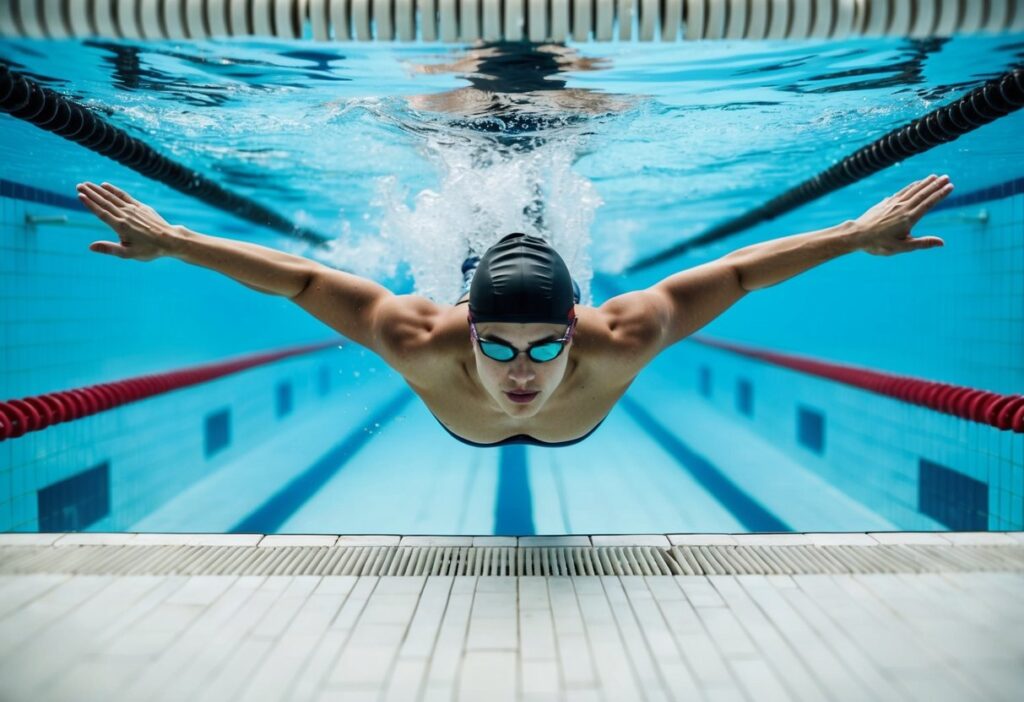
Analysing Performance and Progress
Tracking progress and getting expert feedback are key to improving dive starts and underwater swimming. Swimmers can use technology and work with coaches to refine their technique.
Leveraging Technology and Swim Apps
Modern tech gives swimmers powerful tools to analyse their performance. Swim apps like MySwimPro let athletes log workouts and track progress over time. These apps often include features to time dive starts and underwater sections.
Some pools have underwater cameras that record swimmers. This footage helps pinpoint areas for improvement in the dive and underwater dolphin kicks. Reviewing recordings allows swimmers to see their form from new angles.
Wearable devices can measure reaction times off the blocks. Faster reactions lead to more explosive starts. Tracking this data helps swimmers work on quicker starts.
Assessing Technique with Professional Coaching
Expert coaches provide invaluable feedback on swimming skills. They spot subtle flaws in technique that swimmers may miss on their own. A coach can suggest tweaks to improve dive angles or underwater streamlining.
Coaches often use slow-motion video analysis. This lets them break down each phase of the start and underwater swimming. They can then give specific tips to enhance performance.
Many coaches run drills focused on starts and turns. These drills build muscle memory for proper form. Over time, good technique becomes automatic, leading to faster times.
Regular assessments with a coach track progress. As swimmers improve, coaches adjust training plans to keep pushing their limits. This ongoing feedback loop is crucial for continued growth.
Fine-Tuning Turns and Transitions
Mastering turns and transitions is crucial for improving swimming performance. These elements can shave precious seconds off race times and provide a competitive edge.
Improving Turns for Sprint Events
In sprint events, efficient turns can make a significant difference. Swimmers should focus on approaching the wall at full speed and executing a quick, tight flip.
To perfect the flip turn:
- Keep eyes open underwater to spot the wall
- Tuck chin to chest for a faster somersault
- Push off firmly with both feet
After the turn, maintain a streamlined position and perform powerful dolphin kicks. Aim for 3-5 kicks before transitioning to the swim stroke.
Practice drills:
- Wall somersaults
- Push-off glides
- Timed turn repetitions
Effective Follow-Through from Dive to Stroke
A smooth transition from dive to stroke is essential for maintaining momentum. Swimmers should focus on a streamlined entry and powerful underwater phase.
Key points for an effective follow-through:
- Enter the water through a small ‘hole’
- Maintain a tight streamline position
- Initiate dolphin kicks immediately
As swimmers approach the surface, they should gradually transition to their swim stroke. This process should be fluid and well-practised to avoid losing speed.
Drill idea: Perform dive starts with extended underwater phases, focusing on a seamless transition to swimming.


